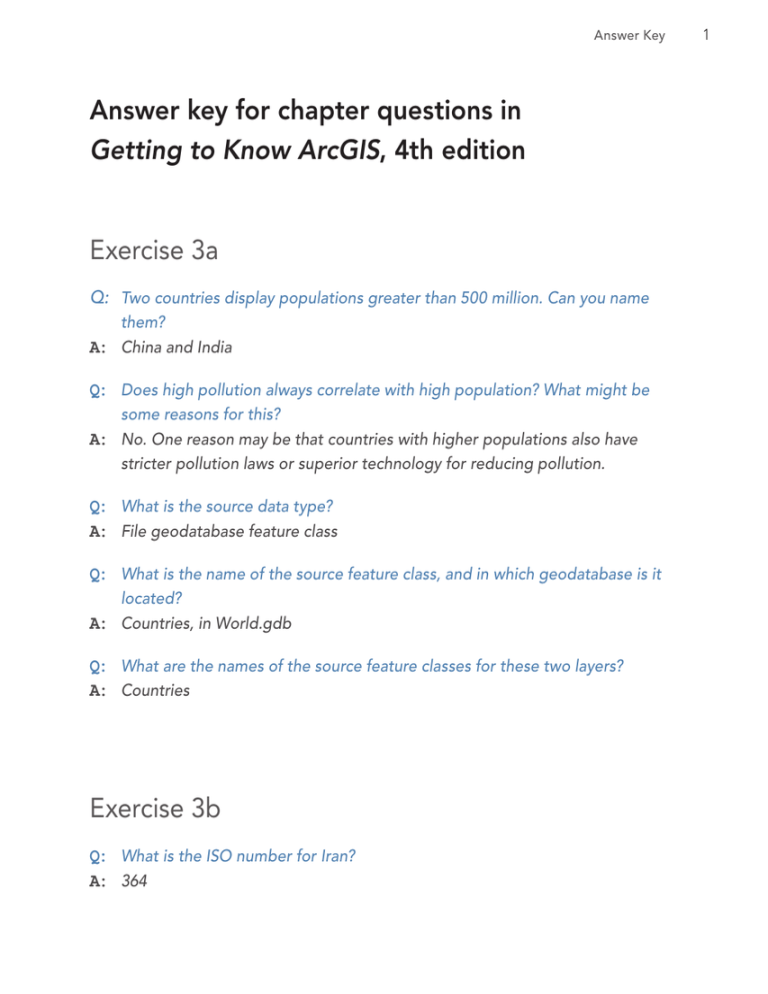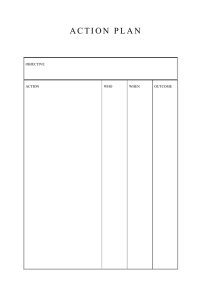Answer key for chapter questions in Getting to Know ArcGIS, fourth
advertisement

Answer Key Answer key for chapter questions in Getting to Know ArcGIS, 4th edition Exercise 3a Q: Two countries display populations greater than 500 million. Can you name them? A: China and India Q: Does high pollution always correlate with high population? What might be some reasons for this? A: No. One reason may be that countries with higher populations also have stricter pollution laws or superior technology for reducing pollution. Q: What is the source data type? A: File geodatabase feature class Q: What is the name of the source feature class, and in which geodatabase is it located? A: Countries, in World.gdb Q: What are the names of the source feature classes for these two layers? A: Countries Exercise 3b Q: What is the ISO number for Iran? A: 364 1 2 Getting to Know ArcGIS, Fourth Edition Exercise 3c Q: The Measure tool calculates the shortest distance between two points. Is the shortest distance between the cities found by traveling over the Atlantic Ocean or the Pacific Ocean? A: The Pacific Exercise 3d Q: What is the total number (sum) of people living in the 12 largest cities? A: 136,941,620 Q: How many selected cities have values under 11,508,260? (Compare your answer to the table to be sure you are reading the chart correctly.) A: Eight Exercise 4a Q: Is Papua New Guinea a UN member state? (You may need to scroll down in the Identify Results window to view the Status attribute.) A: Yes Answer Key Exercise 5a Q: How many levels of detail are there in this basemap? A: 20 Q: Compare the resolution and scale values for two different levels. What does this tell you? A: As the scale becomes larger, the resolution value becomes smaller (meaning an increase in resolution). This also means more tiles are required at larger scales. Exercise 6a Q: How was the POP_CHANGE attribute calculated? A: The difference between population of 2000 and 2010 divided by area. Q: What are the angular units of this coordinate system? A: Degrees Q: What is listed as the prime meridian? A: Greenwich Q: What spheroid does this layer use? A: WGS 84 3 4 Getting to Know ArcGIS, Fourth Edition Exercise 6b Q: Use the Measure tool to measure the distance between two lines of latitude or two lines of longitude. What is the difference in degrees? A: 3.25 degrees Q: Which lines of latitude are defined as standard parallels for this projection? A: 29.5 and 49.5 degrees latitude Exercise 6c Q: What are the spatial extent values of the Colorado counties layer? A: Top: 466927.507131, Bottom: -39875.814597, Left: -1146490.605986, Right: -504618.064701 Q: How does mapping at different map scales using the SPCS and UTM coordinate system affect the overall distortion and accuracy of your map? A: The SPCS was designed for large-scale mapping in the United States. The UTM coordinate system was designed for minimal distortion for areas within each zone. Error and distortion increase for regions that span more than one UTM zone. UTM is not designed for areas that span more than a few zones. Exercise 6D Q: What coordinate system and projection is the map in? A: The coordinate system is North American Datum of 1983 (NAD 83)/World Geodetic System of 1984. The projection is universal transverse Mercator, zone 55. Answer Key Exercise 7a Q: Although lines are typically placed on top of polygons, why does it make sense to put bathymetry lines below polygons? A: Because bathymetry lines can obscure shoreline boundaries. Exercise 7d Q: How would you describe the topography of southern Florida? A: The topography of southern Florida is extremely flat. Exercise 8a Q: Why might these counties have a higher incidence of burglary than surrounding counties? A: There are many factors, but one factor is the higher population density in cities located in these counties. Q: How many elements (or features) are in the other classes? A: There are 17 elements in the second class, and 4 elements in the third class. Exercise 9b Q: When might you choose to place a label directly on a line feature? A: Answers will vary. For example, topo line elevation labels, latitude/longitude labels, routes, interstates, or US highways. 5 6 Getting to Know ArcGIS, Fourth Edition Exercise 10a Q: What type of classification is used to classify these bioregions—categorical or quantitative? A: Categorical Exercise 11a Q: Is the imported coordinate system projected, or is it a geographic coordinate system? A: It is a projected coordinate system. Exercise 12b Q: Is it possible to turn SnapTips off? A: Yes. Exercise 13a Q: In what situations can you imagine map topology would be useful? A: Answers will vary. For example, parcel resizing, political redistricting, moving any feature that must be connected to another (for instance, water lines and fire hydrants). Answer Key Exercise 13c Q: What expression do you anticipate creating to perform this conversion? A: Shape_Area / 43,560 Exercise 14a Q: How does using more fields in the Field Map affect geocoding? A: Using more fields will allow the address locator to make better use of the reference table data when geocoding. Exercise 14c Q: Which coordinate systems are present in the map document? A: The world street map layer is in WGS 1984 Web Mercator Auxiliary Sphere. The other layers are in NAD 1983 State Plane Pennsylvania South. 7 8 Getting to Know ArcGIS, Fourth Edition Exercise 15a Q: Where are the photographs linked from? Where else can they be linked from? A: The photographs are linked from the Chapter 15 data folder. The photographs can also be linked from other locations, including online or from a server. Exercise 16a Q: How many parcels are selected? A: 1,453 Q: Now how many parcels are selected? A: 2,305 Q: Finally, how many parcels are selected? A: 1,275 Exercise 16b Q: How many parcels are currently selected? A: 968 Answer Key Exercise 17a Q: Do you live in or near a food desert? Do you know anyone who is affected by limited access to groceries, especially fresh produce? A: Answers will vary. Q: How does a low-income rural census tract also qualify as a “low-access” tract? A: A significant number of residents live farther than 10 miles from a grocery store. Q: What does the PERCENT_HUNV field measure? (If you have forgotten, revisit the Excel table’s Variable_Lookup sheet.) A: Percentage of housing units without a vehicle with low access to a supermarket or large grocery store Q: How many census tracts in the state of Wisconsin qualify as food deserts? A: 110 Exercise 17b Q: Can you name a county whose entire extent qualifies as a food desert? A: Menominee County Q: What is the name of the largest city in the area? A: Milwaukee Q: How many food deserts does Milwaukee County have? A: 20 9 10 Getting to Know ArcGIS, Fourth Edition Exercise 17c Q: Which county’s food desert population has the highest percentage of children? A: Eau Claire County Exercise 18c Q: How many lookout towers in the Portland CWA are selected? A: 26 Exercise 19a Q: What would happen if the LookoutsBuffer layer was not dissolved? How would that affect how it is used when including it in other forms of geoprocessing? A: There would be multiple buffer features if the dissolve option was not used. Undissolved features are not treated as a single feature and when used in geoprocessing, each feature will be treated individually. Depending on its usage, this would not provide correct results. Answer Key Exercise 20a Q: Can you think of a scenario where it would be important to calculate the direction from the source layer? A: Answers will vary. For instance, calculating a direction output in addition to distance from nearest towns would be useful for emergency helicopter responders. Appendix A Q: If you close your Contents window, how do you restore it? A: View tab > Contents button Q: How would you find a geoprocessing tool? A: Analysis tab > Find Tools button 11



